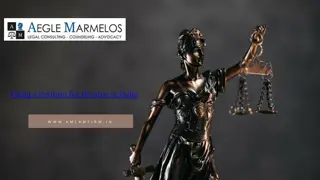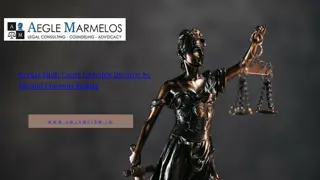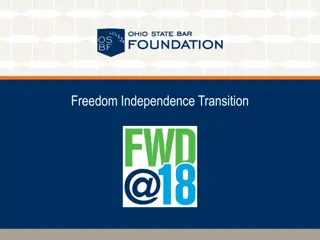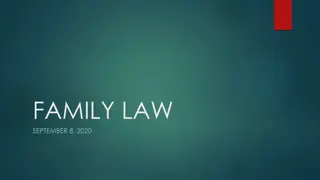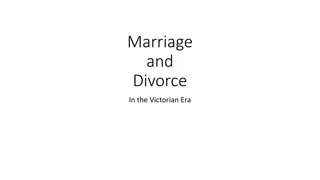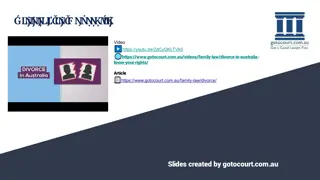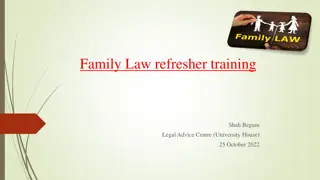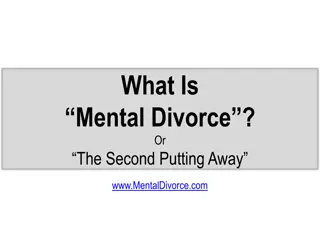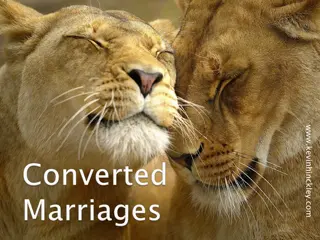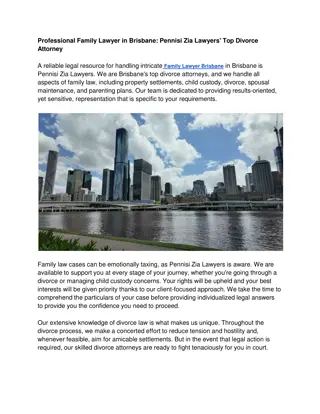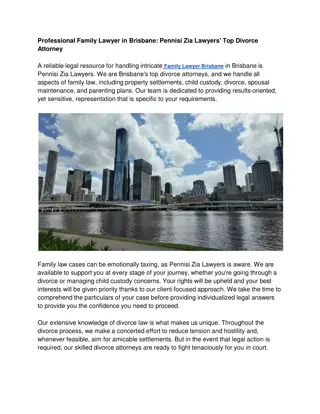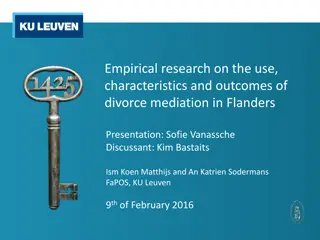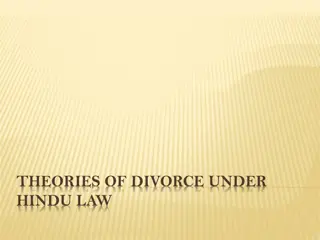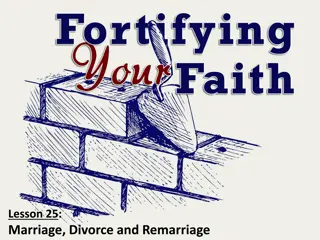Evolution of Marriage and Divorce Trends Throughout History
Explore the changing dynamics of marriage and divorce from the early 19th century to the contemporary 21st century. Delve into historical marriage patterns, reasons people get married, key factors influencing divorce rates, and societal perspectives on matrimony and separation. Witness a shift in values, norms, and laws shaping the institution of marriage over time.
Uploaded on Oct 03, 2024 | 0 Views
Download Presentation

Please find below an Image/Link to download the presentation.
The content on the website is provided AS IS for your information and personal use only. It may not be sold, licensed, or shared on other websites without obtaining consent from the author. Download presentation by click this link. If you encounter any issues during the download, it is possible that the publisher has removed the file from their server.
E N D
Presentation Transcript
MARRIAGE AND DIVORCE Week 11
Outline Overview: Then and Now Why people married 1. Love and romance 2. Convention 3. Money and status 4. Spinsters Matrimonial law Divorce and separation Conclusions
OVERVIEW: THEN AND NOW
Marriage Patterns: 21stcentury Divorce: 1/3 people single. More single men than women (under 65). 42% of marriages end in divorce. Average length of marriage 12 years. 61% of divorces initiated by wives. Unreasonable behaviour most common cause of divorce (aka cruelty pre-1970). Most likely to divorce in late 40s. Marriage: Steady decline in marriage rate in last 50yrs. Usually wives younger than husbands. Average marriage age 35y women/37y men. Religious ceremonies: 28% of marriages. 1/3 people marrying had been married before. ONS 2014/ 16
Marriage and Divorce : Early 19th Century. 1850s 87% of population married. Most single people were female surplus women . Legal age for marriage 12 for girls and 14 for boys. Average age of marriage for women 20-25 and men 25-30. Divorce scandalous, uncommon and preserve of wealthy (cost 475). Between 1765 and 1857 276 divorces granted only 4 of these initiated by women (107,000 in 2016 alone).
WHY PEOPLE MARRIED
1. Love and Romance The age of courtship. Idealised marriage of Victoria and Albert Courtly love and chivalry revival e.g. pre-Raphaelite art Ritual and symbolic: diamond ring/fans/flowers Growth of Valentines day 60,000 cards sent in 1836 . Formal and regulated courtship for upper and middle class. Etiquette books set out courtship codes of conduct. Balls and dances during the London Season . Less formal amongst lower classes.
2. Convention 87% of people were married (Bartley) It is a truth universally acknowledged, that a single man in possession of a good fortune must be in want of a wife . (Pride and Prejudice, 1813) Only career option for women, right of passage for men. Only respectable way to have children.
3. Money and Status For wealthy marriage was way to keep money and power in family (marrying cousins/royalty). Impoverished aristocrats married American heiress for a much need injection of money in return for title. E.g. 1895 Consuelo Vanderbilt (daughter of railway billionaire Willie Vanderbilt) and 9th Duke of Marlborough. Seen to varying extents across social classes.
4. Spinsters Spinster role debated: Claudia Goldin (1980) spinster often lived in poverty low paid, labour intensive, low skilled jobs. Jackie Blount (2000) gender transgressors , respect turned to suspicion leading to unflattering stereotypes. Zsuzsa Berend (2000) unrealistic expectations of marriage and chose not to compromise their high standards. (American Studies: Jstor.org) Sheila Jefferies (1985) - feminists abstain from sex to free life of male abuse and domestic drudgery. Birth control counters these arguments, reinforce heterosexuality and marriage.
Changing Matrimonial Law Secularisation civil marriage (1836) civil divorce (1857). Greater legal status for married women: Married Women s Property Act, 1870. Custody of Children Act, 1839. Jurists tried to ease plight of working class women by allowing magistrates to issue judicial separations rather than expensive divorces.
Changing Matrimonial Law Cont. Matrimonial Causes Act (1878 ): protection orders for wives whose husbands convicted of aggravated assault. Approx. 8,000 granted a year. Maintenance of Wives (desertion) Act (1886): magistrates can order a husband to maintain his wife. Summary Jurisdiction (Married Women) Act (1895): magistrates issue a protection order to women driven from home by husband s cruelty or failure to maintain her and children.
Caroline Sheridan Norton Credited for bringing the issue of marriage and child custody to public and parliamentary scrutiny. Married George Norton in 1827 bearing three sons. In 1836 George Norton sued Lord Melbourne, for damages for adultery with Caroline.
Caroline Sheridan Norton The jury acquitted Melbourne but Caroline reputation was damaged and her legal vindication made divorce impossible. George Norton took their 3 sons abroad and forbade Norton to see them. Norton campaigned to reform laws asking for legal protection for women similar to that recently provided for paupers, insane, prisoners, and other helpless classes.
DIVORCE AND SEPARATION
Divorce Law Before 1857 divorce uncommon and preserve of wealthy men. To divorce you needed: separation order from ecclesiastical court called divorce a mensa et thoro (from bed and board) for adultery, extreme cruelty or desertion; it allowed neither party to re-marry. In a common law court a verdict of adultery against wives had to be obtained called criminal conversation. Apply for a Private Act of Parliament to gain full divorce.
Divorce Law Cont. 1765-1857 there were only 276 divorces. Divorce Act 1857: civil divorce through London divorce court. Still expensive, scandalous and rare. Double standards remained. Men prove adultery women had to prove bigamy, rape, sodomy, bestiality, cruelty, long-term desertion (Bartley)
Separation Much more common than divorce, cheaper and less public (in theory!) Women still supported financially by husband but lived apart. High profile cases: Charles Dickens blamed wife for producing so many children (10), disliked her lack of youth, had affair with Ellen Ternan. Wife moved out with eldest son only. Lord Melbourne PM wife Caroline Lamb obsessed with Lord Byron. Public scandal.
Conclusions Increased recognition that assigning women to husband s control facilitates abuse. Move from sacrament to legal contract = Govt interference more acceptable. Slow move from patriarchal to companionable marriage facilitated by greater female independence. Limited change as men still have greater rights in terms of marriage, custody, separation and divorce until well into 20thc. Marriage still the norm , even today most people marry at some point. However, spinsters more acceptable post WWI. Despite romance and idealism of era this was often sugar coating the realities of marriage which could proved a bitter pill to swallow.




